Solved Examples and Worksheet for Rectangles with Same Area but Different Perimeters and Same Perimeter but Different Areas
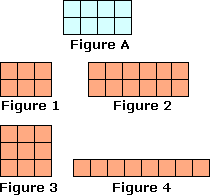
A. Figure 3
B. Figure 4
C. Figure 1
D. Figure 2
Step: 1
The area of the figure on a grid can be found by counting the number of squares enclosed by the figure and its perimeter can be found by adding the lengths of the boundary.
Step: 2
Figure A has an area of 8 square units and a perimeter of 12 units.
Step: 3
Figure 1 has an area of 6 square units and a perimeter of 10 units.
Figure 2 has an area of 12 square units and a perimeter of 16 units.
Figure 2 has an area of 12 square units and a perimeter of 16 units.
Step: 4
Figure 3 has an area of 9 square units and a perimeter of 12 units.
Figure 4 has an area of 8 square units and a perimeter of 18 units.
Figure 4 has an area of 8 square units and a perimeter of 18 units.
Step: 5
Therefore, Figure 3 has the same area as that of Figure A but a different perimeter.
Correct Answer is : Figure 3
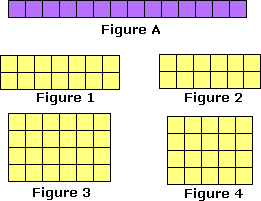
A. Figure 3
B. Figure 1
C. Figure 2
D. Figure 4
Step: 1
The area of the figure on a grid can be found by counting the number of squares enclosed by the figure and its perimeter can be found by adding the lengths of the boundary.
Step: 2
Figure A has an area of 14 square units and a perimeter of 30 units.
Step: 3
Figure 1 has an area of 14 square units and a perimeter of 18 units.
Figure 2 has an area of 12 square units and a perimeter of 16 units.
Figure 2 has an area of 12 square units and a perimeter of 16 units.
Step: 4
Figure 3 has an area of 24 square units and a perimeter of 20 units.
Figure 4 has an area of 20 square units and a perimeter of 18 units.
Figure 4 has an area of 20 square units and a perimeter of 18 units.
Step: 5
Therefore, Figure 1 has the same area as that of Figure A but a different perimeter.
Correct Answer is : Figure 1
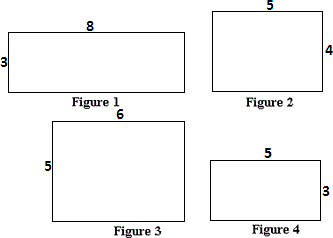
A. Figure 1 and Figure 3
B. Figure 1 and Figure 2
C. Figure 1 and Figure 4
D. Figure 2 and Figure 4
Step: 1
Tiling the given figures based on their side lengths.
Step: 2
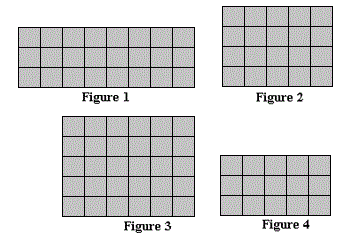
Step: 3
Figure 1 has 3 rows and 8 columns.
Area = 3 × 8 = 24 sq units
Area = 3 × 8 = 24 sq units
[Number of rows × Number of columns]
Step: 4
Perimeter = 3 + 8 + 3 + 8 = 22 units
Step: 5
Figure 2 has 4 rows and 5 columns.
Area = 4 × 5 = 20 sq units.
Area = 4 × 5 = 20 sq units.
Step: 6
Perimeter = 4 + 5 + 4 + 5= 18 units
[Add all the four side lengths.]
Step: 7
Figure 3 has 5 rows and 6 columns.
Area = 5 × 6 = 30 sq units
Area = 5 × 6 = 30 sq units
[Number of rows × Number of columns]
Step: 8
Perimeter = 5 + 6 + 5 + 6 = 22 units
[Add all the four side lengths.]
Step: 9
Figure 4 has 3 rows and 5 columns.
Area = 3 × 5 = 15 sq units
Area = 3 × 5 = 15 sq units
[Number of rows × Number of columns]
Step: 10
Perimeter = 3 + 5 + 3 + 5 = 16 units
[Add all the four side lengths.]
Step: 11
By comparing areas and perimeters of all the given figures, we observed that Figure 1 and Figure 3 have same perimeter but different areas.
Correct Answer is : Figure 1 and Figure 3
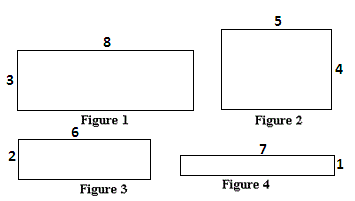
A. Figure 1 and Figure 2
B. Figure 2 and Figure 4
C. Figure 3 and Figure 4
D. Figure 1 and Figure 3
Step: 1
Tiling the given figures based on their side lengths.
Step: 2
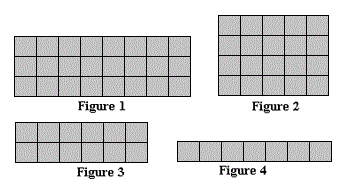
Step: 3
Figure 1 has 3 rows and 8 columns.
Area = 3 × 8 = 24 sq units
Area = 3 × 8 = 24 sq units
[Number of rows × Number of columns]
Step: 4
Perimeter = 3 + 8 + 3 + 8 = 22 units
[Add all the four side lengths.]
Step: 5
Figure 2 has 4 rows and 5 columns.
Area = 4 × 5 = 20 sq units
Area = 4 × 5 = 20 sq units
[Number of rows × Number of columns]
Step: 6
Perimeter = 4 + 5 + 4 + 5= 18 units
[Add all the four side lengths.]
Step: 7
Figure 3 has 2 rows and 6 columns.
Area = 2 × 6 = 12 sq units
Area = 2 × 6 = 12 sq units
[Number of rows × Number of columns]
Step: 8
Perimeter = 2 + 6 + 2 + 6 = 16 units
[Add all the four side lengths.]
Step: 9
Figure 4 has 1 row and 7 columns.
Area = 1 × 7 = 7 sq units
Area = 1 × 7 = 7 sq units
[Number of rows × Number of columns]
Step: 10
Perimeter = 1 + 7 + 1 + 7 = 16 units
[Add all the four side lengths.]
Step: 11
By comparing areas and perimeters of all the given figures, we observed that Figure 3 and Figure 4 have same perimeter but different areas.
Correct Answer is : Figure 3 and Figure 4
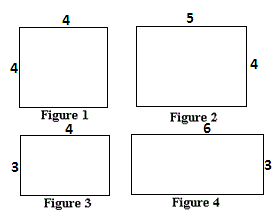
A. Figure 2 and Figure 4
B. Figure 1 and Figure 2
C. Figure 1 and Figure 3
D. Figure 3 and Figure 4
Step: 1
Tiling the given figures based on their side lengths.
Step: 2
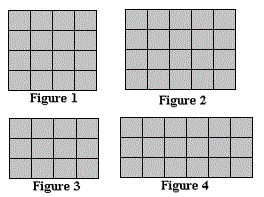
Step: 3
Figure 1 has 4 rows and 4 columns.
Area = 4 × 4 = 16 sq units
Area = 4 × 4 = 16 sq units
[Number of rows × Number of columns]
Step: 4
Perimeter = 4 + 4 + 4 + 4 = 16 units
[Add all the four side lengths.]
Step: 5
Figure 2 has 4 rows and 5 columns.
Area = 4 × 5 = 20 sq units
Area = 4 × 5 = 20 sq units
[Number of rows × Number of columns]
Step: 6
Perimeter = 4 + 5 + 4 + 5= 18 units
[Add all the four side lengths.]
Step: 7
Figure 3 has 3 rows and 4 columns.
Area = 3 × 4 = 12 sq units
Area = 3 × 4 = 12 sq units
[Number of rows × Number of columns]
Step: 8
Perimeter = 3 + 4 + 3 + 4 = 14 units
[Add all the four side lengths.]
Step: 9
Figure 4 has 3 rows and 6 columns.
Area = 3 × 6 = 18 sq units
Area = 3 × 6 = 18 sq units
[Number of rows × Number of columns]
Step: 10
Perimeter = 3 + 6 + 3 + 6 = 18 units
[Add all the four side lengths.]
Step: 11
By comparing areas and perimeters of all the given figures, we observed that Figure 2 and Figure 4 have same perimeter but different areas.
Correct Answer is : Figure 2 and Figure 4
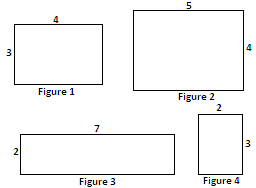
A. Figure 2 and Figure 3
B. Figure 3 and Figure 4
C. Figure 2 and Figure 4
D. Figure 1 and Figure 2
Step: 1
Tiling the given figures based on their side lengths.
Step: 2
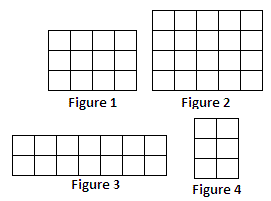
Step: 3
Figure 1 has 3 rows and 4 columns.
Area = 3 × 4 = 12 sq units
Area = 3 × 4 = 12 sq units
[Number of rows × Number of columns]
Step: 4
Perimeter = 3 + 4 + 3 + 4 = 14 units
[Add all the four side lengths.]
Step: 5
Figure 2 has 4 rows and 5 columns.
Area = 4 × 5 = 20 sq units
Area = 4 × 5 = 20 sq units
[Number of rows × Number of columns]
Step: 6
Perimeter = 4 + 5 + 4 + 5 = 18 units
[Add all the four side lengths.]
Step: 7
Figure 3 has 2 rows and 7 columns.
Area = 2 × 7 = 14 sq units
Area = 2 × 7 = 14 sq units
[Number of rows × Number of columns]
Step: 8
Perimeter = 2 + 7 + 2 + 7 = 18 units
[Add all the four side lengths.]
Step: 9
Figure 4 has 3 rows and 2 columns.
Area = 3 × 2 = 6 sq units
Area = 3 × 2 = 6 sq units
[Number of rows × Number of columns]
Step: 10
Perimeter = 3 + 2 + 3 + 2 = 10 units
[Add all the four side lengths.]
Step: 11
By comparing areas and perimeters of all the given figures, we observed that Figure 2 and Figure 3 have same perimeter but different areas.
Correct Answer is : Figure 2 and Figure 3
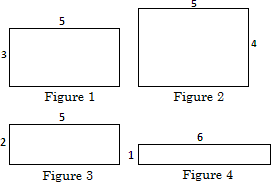
A. Figure 2 and Figure 4
B. Figure 1 and Figure 2
C. Figure 3 and Figure 4
D. Figure 2 and Figure 3
Step: 1
Tiling the given figures based on their side lengths.
Step: 2
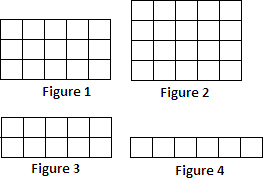
Step: 3
Figure 1 has 3 rows and 5 columns.
Area = 3 × 5 = 15 sq units
Area = 3 × 5 = 15 sq units
[Number of rows × Number of columns]
Step: 4
Perimeter = 3 + 5 + 3 + 5 = 16 units
[Add all the four side lengths.]
Step: 5
Figure 2 has 4 rows and 5 columns.
Area = 4 × 5 = 20 sq units
Area = 4 × 5 = 20 sq units
[Number of rows × Number of columns]
Step: 6
Perimeter = 4 + 5 + 4 + 5 = 18 units
[Add all the four side lengths.]
Step: 7
Figure 3 has 2 rows and 5 columns.
Area = 2 × 5 = 10 sq units
Area = 2 × 5 = 10 sq units
[Number of rows × Number of columns]
Step: 8
Perimeter = 2 + 5 + 2 + 5 = 14 units
[Add all the four side lengths.]
Step: 9
Figure 4 has 1 row and 6 columns.
Area = 1 × 6 = 6 sq units
Area = 1 × 6 = 6 sq units
[Number of rows × Number of columns]
Step: 10
Perimeter = 1 + 6 + 1 + 6 = 14 units
[Add all the four side lengths.]
Step: 11
By comparing areas and perimeters of all the given figures, we observed that Figure 3 and Figure 4 have same perimeter but different areas.
Correct Answer is : Figure 3 and Figure 4
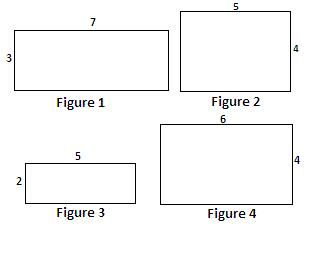
A. Figure 2 and Figure 4
B. Figure 1 and Figure 4
C. Figure 1 and Figure 2
D. Figure 3 and Figure 4
Step: 1
Tiling the given figures based on their side lengths.
Step: 2
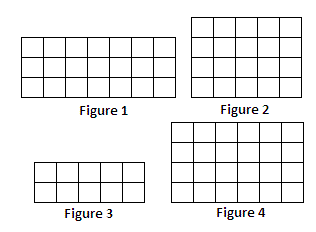
Step: 3
Figure 1 has 3 rows and 7 columns.
Area = 3 × 7 = 21 sq units
Area = 3 × 7 = 21 sq units
[Number of rows × Number of columns]
Step: 4
Perimeter = 3 + 7 + 3 + 7 = 20 units
[Add all the four side lengths.]
Step: 5
Figure 2 has 4 rows and 5 columns.
Area = 4 × 5 = 20 sq units
Area = 4 × 5 = 20 sq units
[Number of rows × Number of columns]
Step: 6
Perimeter = 4 + 5 + 4 + 5 = 18 units
[Add all the four side lengths.]
Step: 7
Figure 3 has 2 rows and 5 columns.
Area = 2 × 5 = 10 sq units
Area = 2 × 5 = 10 sq units
[Number of rows × Number of columns]
Step: 8
Perimeter = 2 + 5 + 2 + 5 = 14 units
[Add all the four side lengths.]
Step: 9
Figure 4 has 4 rows and 6 columns.
Area = 4 × 6 = 24 sq units
Area = 4 × 6 = 24 sq units
[Number of rows × Number of columns]
Step: 10
Perimeter = 4 + 6 + 4 + 6 = 20 units
[Add all the four side lengths.]
Step: 11
By comparing areas and perimeters of all the given figures, we observed that Figure 1 and Figure 4 have same perimeter but different areas.
Correct Answer is : Figure 1 and Figure 4
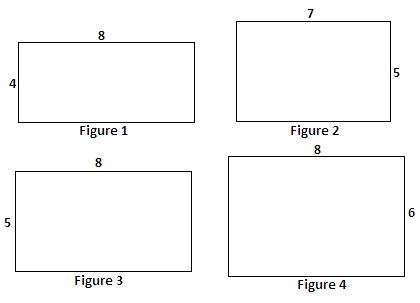
A. Figure 1 and Figure 2
B. Figure 3 and Figure 4
C. Figure 2 and Figure 3
D. Figure 1 and Figure 4
Step: 1
Tiling the given figures based on their side lengths.
Step: 2
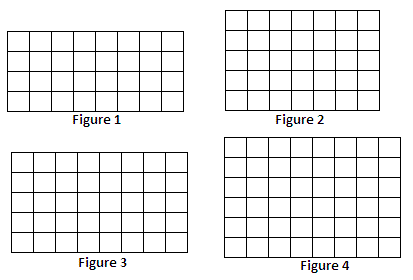
Step: 3
Figure 1 has 4 rows and 8 columns.
Area = 4 × 8 = 32 sq units
Area = 4 × 8 = 32 sq units
[Number of rows × Number of columns]
Step: 4
Perimeter = 4 + 8 + 4 + 8 = 24 units
[Add all the four side lengths.]
Step: 5
Figure 2 has 5 rows and 7 columns.
Area = 5 × 7 = 35 sq units
Area = 5 × 7 = 35 sq units
[Number of rows × Number of columns]
Step: 6
Perimeter = 5 + 7 + 5 + 7 = 24 units
[Add all the four side lengths.]
Step: 7
Figure 3 has 5 rows and 8 columns.
Area = 5 × 8 = 40 sq units
Area = 5 × 8 = 40 sq units
[Number of rows × Number of columns]
Step: 8
Perimeter = 5 + 8 + 5 + 8 = 26 units
[Add all the four side lengths.]
Step: 9
Figure 4 has 6 rows and 8 columns.
Area = 6 × 8 = 48 sq units
Area = 6 × 8 = 48 sq units
[Number of rows × Number of columns]
Step: 10
Perimeter = 6 + 8 + 6 + 8 = 28 units
[Add all the four side lengths.]
Step: 11
By comparing areas and perimeters of all the given figures, we observed that Figure 1 and Figure 2 have same perimeter but different areas.
Correct Answer is : Figure 1 and Figure 2
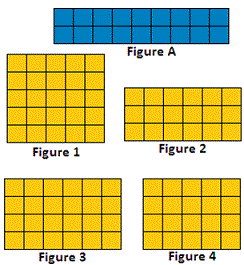
A. Figure 4
B. Figure 2
C. Figure 1
D. Figure 3
Step: 1
Figure A has 2 rows and 9 columns.
Step: 2
Area = 2 × 9 = 18 sq units
[Number of rows × Number of columns.]
Step: 3
Perimeter = 2 + 9 + 2 + 9 = 22 units
[Add all the four side lengths.]
Step: 4
Figure 1 has 5 rows and 5 columns.
Step: 5
Area = 5 × 5 = 25 sq units
[Number of rows × Number of columns.]
Step: 6
Perimeter = 5 + 5 + 5 + 5 = 20 units
[Add all the four side lengths.]
Step: 7
Figure 2 has 3 rows and 6 columns.
Step: 8
Area = 3 × 6 = 18 sq units
[Number of rows × Number of columns.]
Step: 9
Perimeter = 3 + 6 + 3 + 6 = 18 units
[Add all the four side lengths.]
Step: 10
Figure 3 has 4 rows and 6 columns.
Step: 11
Area = 4 × 6 = 24 sq units
[Number of rows × Number of columns.]
Step: 12
Perimeter = 4 + 6+ 4 + 6 = 20 units
[Add all the four side lengths.]
Step: 13
Figure 4 has 4 rows and 5 columns.
Step: 14
Area = 4 × 5 = 20 sq units
[Number of rows × Number of columns.]
Step: 15
Perimeter = 4 + 5 + 4 + 5 = 18 units
[Add all the four side lengths.]
Step: 16
By comparing areas and perimeters of all the given figures, we observed that Figure A and Figure 2 has same areas but different perimeters.
Correct Answer is : Figure 2
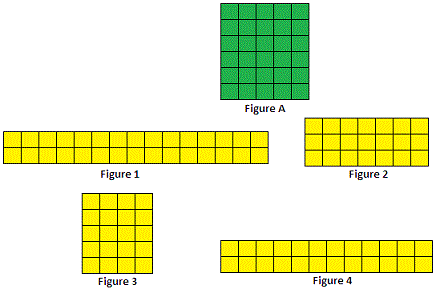
A. Figure 4
B. Figure 3
C. Figure 2
D. Figure 1
Step: 1
Figure A has 6 rows and 5 columns.
Area = 6 × 5 = 30 sq units
Area = 6 × 5 = 30 sq units
[Number of rows × Number of columns]
Step: 2
Perimeter = 6 + 5 + 6 + 5 = 22 units
[Add all the four side lengths.]
Step: 3
Figure 1 has 2 rows and 15 columns.
Area = 2 × 15 = 15 × 2 = 30 sq units
Area = 2 × 15 = 15 × 2 = 30 sq units
[Number of rows × Number of columns]
Step: 4
Perimeter = 2 + 15 + 2 + 15= 34 units
[Add all the four side lengths.]
Step: 5
Figure 2 has 3 rows and 7 columns.
Area = 3 × 7 = 21 sq units
Area = 3 × 7 = 21 sq units
[Number of rows × Number of columns]
Step: 6
Perimeter = 3 + 7 + 3 + 7 = 20 units
[Add all the four side lengths.]
Step: 7
Figure 3 has 5 rows and 4 columns.
Area = 5 × 4 = 20 sq units
Area = 5 × 4 = 20 sq units
[Number of rows × Number of columns]
Step: 8
Perimeter = 5 + 4 + 5 + 4 = 18 units
[Add all the four side lengths.]
Step: 9
Figure 4 has 2 rows and 12 columns.
Area = 2 × 12 = 12 × 2 = 24 sq units
Area = 2 × 12 = 12 × 2 = 24 sq units
[Number of rows × Number of columns]
Step: 10
Perimeter = 2 + 12 + 2 + 12 = 28 units
[Add all the four side lengths.]
Step: 11
By comparing areas and perimeters of all the given figures, we observed that Figure A and Figure 1 has same areas but different perimeters.
Correct Answer is : Figure 1
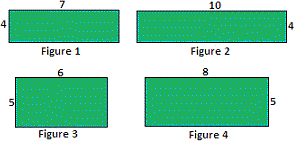
A. Figure 1 and Figure 4
B. Figure 1 and Figure 3
C. Figure 3 and Figure 3
D. Figure 2 and Figure 4
Step: 1
Tiling the given figures based on their side lengths.
Step: 2
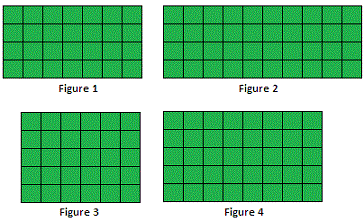
Step: 3
Figure 1 has 4 rows and 7 columns.
Area = 4 × 7 = 28 sq units
Area = 4 × 7 = 28 sq units
[Number of rows × Number of columns]
Step: 4
Perimeter = 4 + 7 + 4 + 7 = 22 units
[Add all the four side lengths.]
Step: 5
Figure 2 has 4 rows and 10 columns.
Area = 4 × 10 = 10 × 4 = 40 sq units
Area = 4 × 10 = 10 × 4 = 40 sq units
[Number of rows × Number of columns]
Step: 6
Perimeter = 4 + 10 + 4 + 10= 28 units
[Add all the four side lengths.]
Step: 7
Figure 3 has 5 rows and 6 columns.
Area = 5 × 6 = 30 sq units
Area = 5 × 6 = 30 sq units
[Number of rows × Number of columns]
Step: 8
Perimeter = 5 + 6 + 5 + 6 = 22 units
[Add all the four side lengths.]
Step: 9
Figure 4 has 5 rows and 8 columns.
Area = 5 × 8 = 40 sq units
Area = 5 × 8 = 40 sq units
[Number of rows × Number of columns]
Step: 10
Perimeter = 5 + 8 + 5 + 8 = 26 units
[Add all the four side lengths.]
Step: 11
By comparing areas and perimeters of all the given figures, we observed that Figure 2 and Figure 4 has same areas but different perimeters.
Correct Answer is : Figure 2 and Figure 4
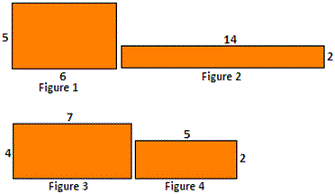
A. Figure 3 and Figure 4
B. Figure 1 and Figure 4
C. Figure 2 and Figure 3
D. Figure 1 and Figure 3
Step: 1
Tiling the given figures based on their side lengths.
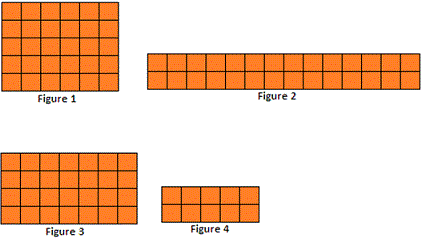

Step: 2
Figure 1 has 5 rows and 6 columns.
Step: 3
Area = 5 × 6 = 30 sq units
[Number of rows × Number of columns.]
Step: 4
Perimeter = 5 + 6 + 5 + 6 = 22 units
[Add all the four side lengths.]
Step: 5
Figure 2 has 2 rows and 14 columns.
Step: 6
Area = 2 × 14 = 14 × 2 = 28 sq units
[Number of Rows × Number of Columns.]
Step: 7
Perimeter = 2 + 14 + 2 + 25 = 32 units
[Add all the four side lengths.]
Step: 8
Figure 3 has 4 rows and 7 columns.
Step: 9
Area = 4 × 7 = 28 sq units
[Number of rows × Number of columns.]
Step: 10
Perimeter = 4 + 7 + 4 + 7 = 22 units
[Add all four side lengths.]
Step: 11
Figure 4 has 2 rows and 5 columns.
Step: 12
Area = 2 × 5 = 10 sq units
[Number of rows × Number of columns.]
Step: 13
Perimeter = 2 + 5 + 2 + 5 = 14 units
[Add all the four side lengths.]
Step: 14
By comparing areas and perimeters of all the given figures, we observed that Figure 2 and Figure 3 has same areas but different perimeters.
Correct Answer is : Figure 2 and Figure 3
- Telling Time to the nearest Minute-Gr 3-Solved Examples
- Elapsed Time-Gr 3-Solved Examples
- Measuring Length Using Ruler-Gr 3-Solved Examples
- Estimating Metric Units-Gr 3-Solved Examples
- Using Operations to Solve Problems Involving Volume and Mass-Gr 3-Solved Examples
- Perimeter of Polygons-Gr 3-Solved Examples
- Finding an Unknown Dimension of a Polygon-Gr 3-Solved Examples
- Finding Area of Rectangles by Tiling-Gr 3-Solved Examples
- Area of Plane Figures - Counting Unit Squares-Gr 3-Solved Examples
- Finding Areas of Rectilinear Figures-Gr 3-Solved Examples
- Solving Problems on Area of Rectangles-Gr 3-Solved Examples
- Representing Distributive Property Using Area Models-Gr 3-Solved Examples
- Constructing Pictographs-Gr 3-Solved Examples
- Constructing Bar Graphs-Gr 3-Solved Examples
- Interpreting Bar Graphs-Gr 3-Solved Examples